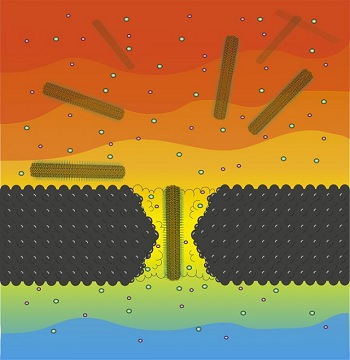Sep 30 2014
Researchers at the University of Pennsylvania have used a rapid gene sequencing technique to measure nanoscopic structures.
 A nanocrystal passes through a silicon nitride nanopore. Image Credit: University of Pennsylvania
A nanocrystal passes through a silicon nitride nanopore. Image Credit: University of Pennsylvania
Using a technique known as a ‘nanopore translocation’, nanoscale rods and spheres were passed through a very small hole in a thin membrane in order to determine the surface electrical properties of the structures.
Penn researchers have been studying gene sequencing with the translocation of DNA through nanopores. They suspended DNA in ionic fluid and then threaded it through a very small hole. DNA sequences consist of four bases and each of these bases allow different amount of ions to pass through, with the variations in the ion current helping to identify the bases.
Coulter counters have previously been used to count and sort microscopic particles. Large diameter particles obstruct a larger section of the aperture, which allows electrodes to measure a lower current value. While Coulter counters can be used for microscopic particles, DNA bases require nanoscale pores, which are now possible thanks to recent advancements in technology.
Oblong nanorods and spherical nanocrystals could find applications in electronics and medical devices but the ability to obtain more accurate measurements of their properties is required. The researchers used solid-state nanopores with diameters which could be changed as required.
Ligands were used to coat the gold nanorods and nanospheres of uniform size, which provided a positive charge. The amount of ligand coverage influenced the quality and function of the nanoparticles.
The researchers calibrated their measurement system using spherical nanoparticles. However, the system was not suitable for non-spherical nanoparticles. Using computational models, the researchers calculated the nanorods’ surface charge density based on its diameter. Hence, if the surface charge density of the material was known then its diameter could be calculated.
The team also discovered that nanorods reduce the ionic current when they pass through the pores. However, they found that the ionic current increased certain times, which they linked it to the nearness between the pore edge and the nanorod. They suspect that in smaller pores the charged surfaces of the pores and rods attracted more ions.
This phenomenon could potentially be used as an alternative method to measuring particles which pass through pores. The Penn researchers have published this study in Nano Letters.